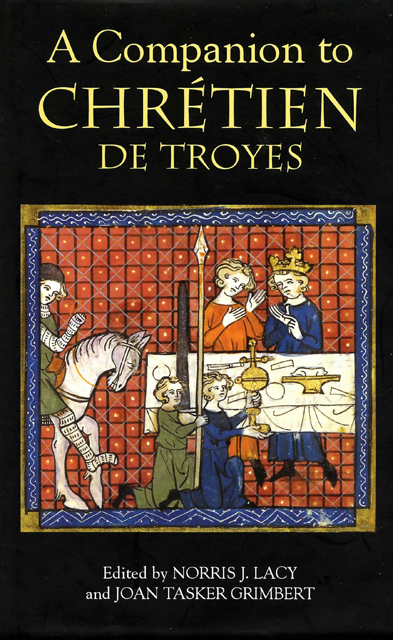13 - Le Conte du Graal: Chrétien’s Unfinished Last Romance
Published online by Cambridge University Press: 23 March 2023
Summary
Chrétien's commentary in the prologues and epilogues of his last three romances reveals a shifting perspective with respect to his primary protagonists. In earlier works they are referred to in ways that eventually give rise to eponymous titles: ‘Cil qui fist D’Erec et d’Enide’ [The one who wrote about Erec and Enide], and, in reference to Cligés, ‘Un novel conte recomance / D’un vaslet qui an Grece fu / Del linage le roi Artu’, vss 8–10 [begins a new story about a youth descended from King Arthur who lived in Greece], where the metonymic circumlocution reflects the narrator's plan not to name his main protagonist until it is time for his story. Later, in the intertwined ‘twin romances’, Chrétien modifies the strategy exemplified in Cligés: ‘Del Chevalier de la charrete / Comance Crestïens son livre’ [Chrétien begins his book about the Knight of the Cart], where the hero is not named until the mid-point, and ‘Del chevalier al lion fine / Crestïens son romant issi’ [Thus Chrétien ends his romance about the Knight of the Lion], where Yvain is not seen until after Calogrenant tells his story. In these references Chrétien retains generic terms (conte, livre, romans) and continues using verbs defining the narrative act (rancomance, comance, fine), but he now claims possession of his work (‘son livre’, ‘son romant’) and, more significantly, metonymy shifts from circumlocution to the use of surnames in anticipation of the principle, expressed by Perceval's mother, that a man's surname is the key to knowing who he is. The cart and the lion are an object and a creature encountered while en aventure [pursuing adventure] that become so intimately associated with the protagonists that the latter are transformed.
One of many distinctive features of Chrétien's last romance is that he endows it with a title, whereas ‘Cil qui fist d’Erec et d’Enide’ and ‘Del chevalier al lion fine / Crestïens son romant issi’ are not titles at all, but contain germs from which titles eventually emerge in tradition. ‘Ce est li Contes del Graal’, vs. 66 [It is the story of the Grail] presents a stand-alone title that can be extracted from Chrétien's verse without alteration where genre and subject matter are not distanced but conjoined.
- Type
- Chapter
- Information
- A Companion to Chrétien de Troyes , pp. 169 - 188Publisher: Boydell & BrewerPrint publication year: 2005



